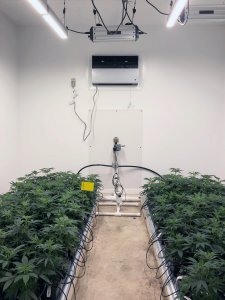Tory Moore, Public Relations Specialist, UF/IFAS Communications
New UF/IFAS research suggests Florida growers must carefully select hemp varieties and factor the length of a given day when scheduling when to plant.
Understanding hemp flowering behavior, or how it responds to light and varying daylengths in tropical and subtropical climates has a boost thanks to new research from UF/IFAS published in Frontiers in Plant Science.
Hemp needs sufficient time for vegetative growth to take place before the photoperiod hits, causing the plant to flower. Planting a hemp crop too late or planting a variety that is incompatible with the day length of the region could cause the plants to flower too soon and lead to an unsuccessful crop.
Some plants, including hemp, are highly sensitive to the amount of day length they receive. Modern hemp cultivars tend to originate from temperate regions where the longest day length is around 15.5 hours. In Apopka, average daylength is closer to 14 hours. Key Largo only gets 13.5 hours on the longest day.
“Identifying cultivars that can tolerate Florida’s environmental conditions is key to optimizing the performance of hemp,” said Brian Pearson, UF/IFAS assistant professor of crop management. “Florida’s short day lengths are one of the greatest challenges to hemp success and we wanted to dig deeper to better understand how to grow hemp successfully here since a large amount of our hemp acreage is outdoors.”
Hemp has shown to have optimal photoperiods ranging from 12 hours to 18 hours dependent upon the variety, leaving more questions than answers regarding optimal photoperiod.
“Hemp grown in Florida faces a lot of challenges,” Zachary Brym, agronomy assistant professor said. “From pest and disease pressure to the high temperatures and humidity, there are a lot of factors that can make growing hemp here difficult. The short daylengths present one of the greatest challenges that this research helped address.”
 The research team studied 15 cultivars of essential oil hemp and 12 fiber/grain cultivars grown in controlled growth chambers. The goals were to identify critical photoperiod needed to induce flowering, compare photoperiod thresholds to flowering dates within a subtropical outdoor environment, and quantify how hemp cultivars respond under different photoperiods.
The research team studied 15 cultivars of essential oil hemp and 12 fiber/grain cultivars grown in controlled growth chambers. The goals were to identify critical photoperiod needed to induce flowering, compare photoperiod thresholds to flowering dates within a subtropical outdoor environment, and quantify how hemp cultivars respond under different photoperiods.
Most of the essential oil cultivars and some of the fiber or grain cultivars were found to be suitable for Florida’s daylight hours, but some were sensitive enough that just 15 minutes made a difference in their productivity. So, planting date becomes a critical factor for cultivation outdoors.
The study also found that hemp is very sensitive to low levels of light. Light available just prior to sunrise and just after sunset, also known as civil twilight, is influential to the flowering of hemp. Thus, daylength estimations should include the civil twilight period when determining the photoperiod of a location.
Despite great diversity observed in photoperiod response, the study identified several essential oil, fiber, and grain hemp varieties that responded favorably to daylengths experienced throughout Florida.
“Careful variety selection is extremely important for Florida growers,” Brym said. “It will be important that Florida growers select hemp varieties from southern latitudes and avoid those from the north. Growers should also consider day neutral or “autoflower” hemp that can withstand Florida’s heat and humidity.”
–
For more information on UF/IFAS hemp research, visit the hemp resources site.
- Where Did That Weed Come From? The Importance of Weed Management Practices and Timings - December 5, 2025
- Sustainable U.S. Peanuts Kicks Off 2025 Crop Enrollment - December 5, 2025
- Grant Opportunity Available to Attend American Forage & Grassland Council Conference, Ashville – January 12-15 - December 5, 2025
